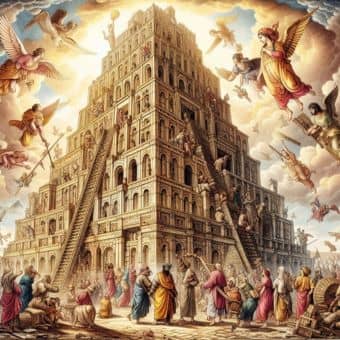Unraveling the Mysteries of the Tower of Babel
History, Myth, and Its Lasting Legacy
The Tower of Babel, one of humanity’s most enduring legends, has fascinated scholars, theologians, and the curious for centuries.
This tale of ambition, divine intervention, and the ensuing linguistic fragmentation has its roots deeply embedded in biblical texts, primarily in Genesis 11:1-9. Yet, its impact extends far beyond its scriptural origins, influencing art, architecture, and the discourse about cultural and linguistic diversity.
This blog post contains affiliate links. When you click on a link on this page and make a purchase I may earn a small commission, at no additional cost to you. Thank you for your support.
Understanding the Myth
According to the narrative found in the Book of Genesis, humanity, speaking a single language, congregated in the land of Shinar and agreed to build a city with a tower “whose top may reach unto heaven.”
The purpose of this tower was not merely architectural ambition but also a symbol of unity and power that could prevent them from being scattered across the earth.
However, the biblical God, observing their pride and potential, confounded their speech and dispersed them worldwide, leading to the multiplicity of languages that characterize the human experience. The Tower of Babel serves as a poignant explanation for the diversity of languages and, allegorically, the challenges of human communication.

Archaeological Evidence and Historical Context
It is widely believed by historians and archaeologists that the Tower of Babel drew inspiration from the real ziggurats of Mesopotamia—massive structures built as terraced compounds of shrines and sanctuaries.
The most prominent ziggurat, Etemenanki, which stood in ancient Babylon, is often cited as a plausible source for the Tower of Babel myth due to its colossal size and purpose as a religious edifice meant to bridge the earth and the heavens.
While no archaeological finding conclusively confirms the existence of the Tower of Babel as described in the Bible, these Mesopotamian step pyramids provide valuable context and add a layer of credibility to the narrative by grounding it in historical practice.
The Tower’s Symbolic Legacy
The Tower of Babel has evolved to become a powerful symbol for various concepts, including the perils of human pride, the value of diversity, and the inherent difficulties in complete global communication.
Implications for Language and Culture
Linguistically, the story of the Tower of Babel echoes the evolutionary and dynamic nature of languages. Just as the story speaks of the emergence of different tongues, languages continue to evolve, branch out, and borrow from one another in a complex tapestry reflective of human culture and migration.
Influence on Art and Literature
Artists and writers have grappled with the imagery and implications of the Tower of Babel for ages.
From Pieter Bruegel the Elder’s famous painting, which presents the tower as a colossal, spiraling structure of chaos and hubris, to modern literary works that use the tower as a metaphor for the modern struggles with multilingualism and globalization, the Tower of Babel’s imagery is deeply entrenched in cultural dialogues.
Modern Interpretations and Relevance
Today, the Tower of Babel can be viewed as a precursor to modern discussions about globalization and communication.
In an era of rapid technological advancement where linguistic barriers are both broken and reinforced, the Tower of Babel’s myth reminds us of our history of linguistic unity and disunity, the double-edged sword of human ambition, and the need for mutual understanding and respect in a multicultural world.
Closing Thoughts
The story of the Tower of Babel, while ancient, continues to assert its relevance in contemporary society. It serves as a powerful reminder of our interconnectedness, the variety inherent in human civilization, and the importance of striving for harmony amidst diversity.
In exploring the Tower of Babel, we are prompted to reflect on language as a tool that unites and divides, on the spirit of cooperation, and the ever-present human desire to reach new heights.
If you found this content helpful, you can support Moody Catholic and keep this blog ad free by making a donation of any amount. Learn more by reading the – Support Our Blog page.
